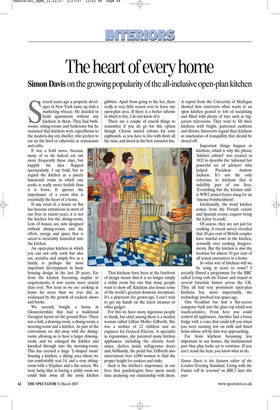The heart of every home
Simon Davison the growing popularity of the all-inclusive open-plan kitchen Several years ago a property developer in New York came up with a marketing wheeze. He decided to build apartments without any kitchens in them. They had bathrooms, sitting-rooms and bedrooms but he reasoned that kitchens were superfluous to the modern-day city dweller, who prefers to eat on the hoof or otherwise in restaurants and cafés.
It was a bold move, because many of us do indeed eat out more frequently these days, but happily his idea flopped spectacularly. I say bold, but to regard the kitchen as a purely functional room in which one cooks is really more foolish than it is brave. It ignores the importance of a room that is essentially the heart of a home.
If any room in a house or flat has become extraneous to most of our lives in recent years, it is not the kitchen but the dining-room. Lots of houses are now designed without dining-rooms and the effort, energy and space that is saved is invariably funnelled into the kitchen.
An open-plan kitchen in which you can not only cook but also eat, socialise and simply live as a family is perhaps the most important development in basic housing design in the last 20 years. Far from the kitchen becoming surplus to requirements, it now seems more crucial than ever. Not least as we are cooking at home far more than we ever did, as evidenced by the growth of cookery shows and books.
We recently bought a house in Gloucestershire that had a traditional Georgian layout on the ground floor. There was a hall, a drawing-room, a dining-room, a morning-room and a kitchen. As part of the renovations we did away with the diningroom, allowing us to have a larger drawingroom, and we enlarged the kitchen and knocked through into the morning-room. This has created a large ‘L-shaped room’ housing a kitchen, a dining area where we can comfortably seat 14, and a cosy sittingroom with a fireplace and a flat screen. We were lucky that in having a utility room we could hide away all the noisy kitchen gubbins. Apart from going to the loo, there really is very little reason ever to leave our open-plan area. If there is a better scheme in which to live, I do not know of it.
There are a couple of crucial things to remember if you do go for this option though. Choose muted colours for your cupboards, as you have to live with them all the time, and invest in the best extractor fan.
That kitchens have been at the forefront of design means that it is no longer simply a utility room but one that many people want to show off. Kitchens also house some of the world’s greatest domestic inventions. It’s a playroom for grown-ups. I can’t wait to get my hands on the latest steamer or other gadget.
For this we have many ingenious people to thank, but chief among them is a modest woman called Lillian Moller Gilbreth. She was a mother of 12 children and an engineer for General Electric. A specialist in ergonomics, she patented many kitchen appliances, including the electric foodmixer, shelves inside refrigerator doors and, brilliantly, the pedal bin. Gilbreth also interviewed over 4,000 women to find the proper height for cookers and sinks.
Such is the kitchen’s importance in our lives that psychologists have spent much time analysing our relationship with them. A report from the University of Michigan showed how extroverts often warm to an open kitchen geared to lots of socialising and filled with plenty of toys such as bigscreen televisions. They tend to fill their kitchens with bright, patterned cushions and throws. Introverts regard their kitchens as sanctuaries of tranquillity that should be closed off.
Important things happen in kitchens, which is why the phrase ‘kitchen cabinet’ was created in 1832 to describe the ‘informal but powerful set of advisers’ who helped President Andrew Jackson. It’s not the only reference to kitchens that is indelibly part of our lives. ‘Everything but the kitchen sink’ is WW2 armed forces slang for an ‘intense bombardment’.
Incidentally, the word kitchen comes from the French cuisine and Spanish cocina, coquere being the Latin ‘to cook’.
Of course, they are not just for cooking. A recent survey revealed that 30 per cent of British couples have marital rows in the kitchen, normally over cooking disagreements. But the kitchen is also the location for almost 10 per cent of all sexual encounters in a home.
So what sort of kitchens will we be using in years to come? I recently filmed a programme for the BBC called Living with the Future and stayed in several futuristic homes across the UK. They all had very prominent open-plan kitchens but, more importantly, the technology involved was space-age.
One breakfast bar had a flat-screen computer built into the glass top which was touch-sensitive. From here you could control all appliances. Another had a bossy fridge with a voice that could tell you when you were running low on milk and listed items whose sell-by date was approaching.
Far from kitchens becoming less important in our homes, the fundamental part they play looks set to continue. If you can’t stand the heat, you know what to do.
Simon Davis is the features editor of the London Evening Standard. Living with the Future will be screened on BBC2 later this year.










































































 Previous page
Previous page